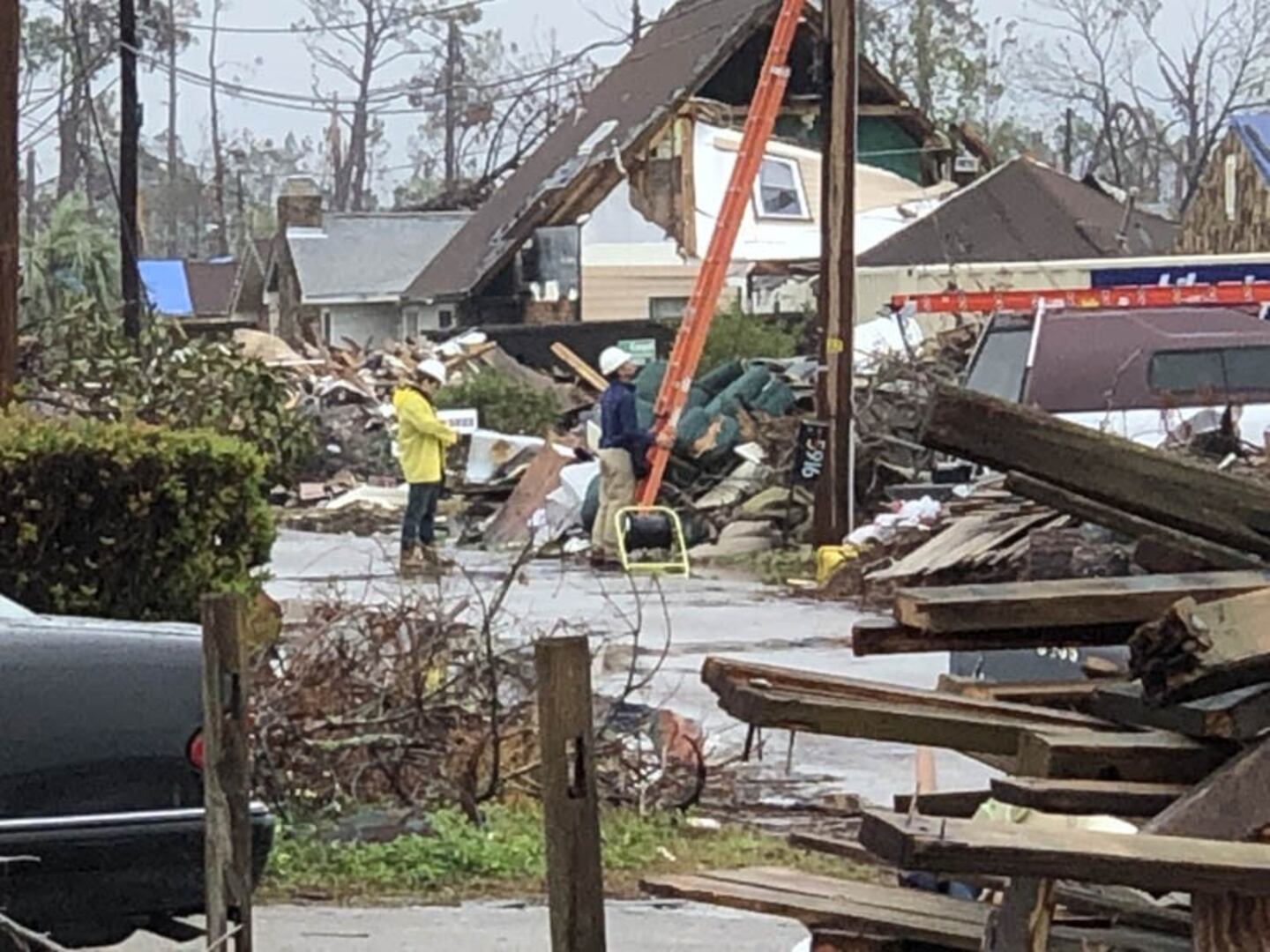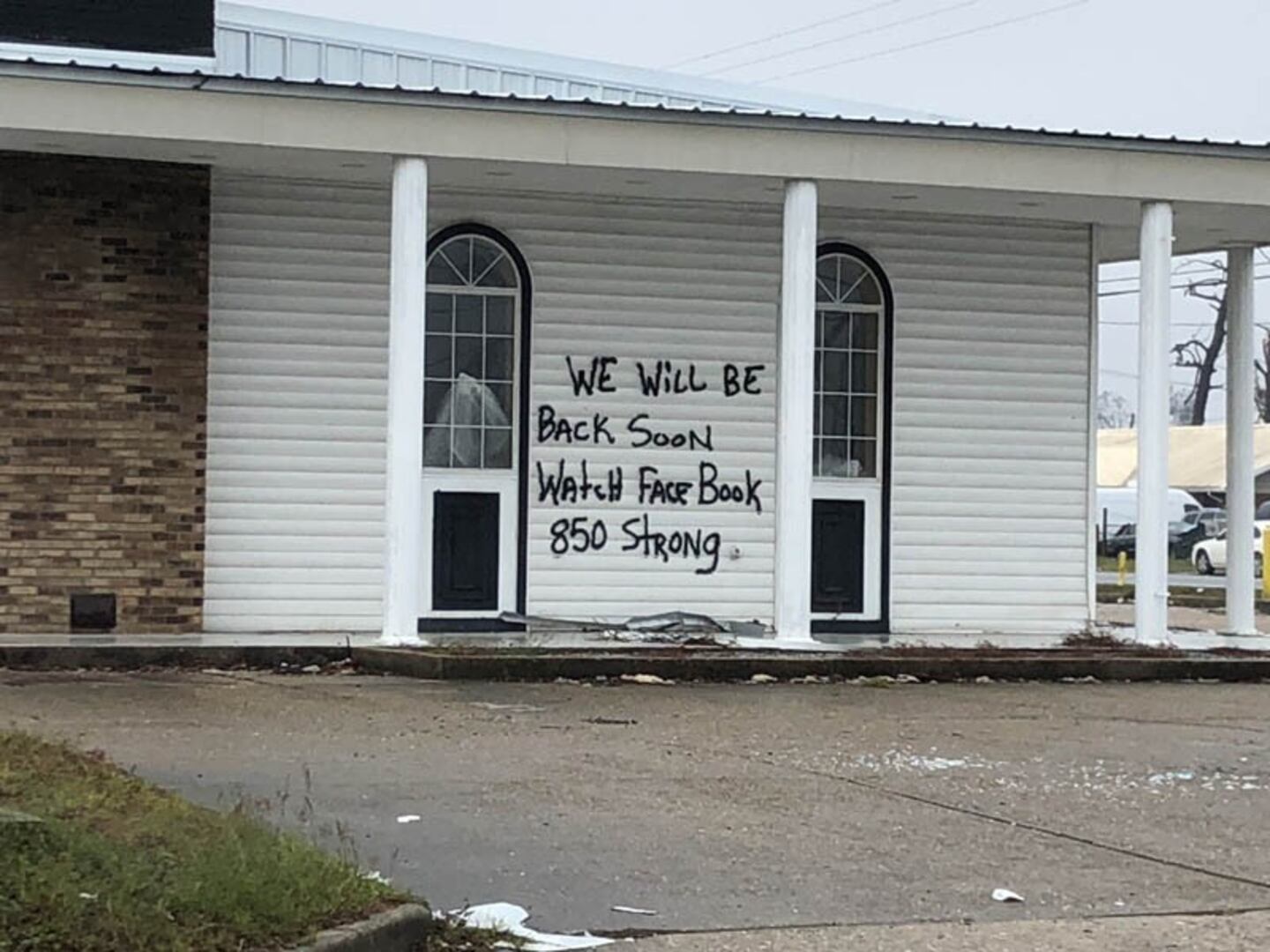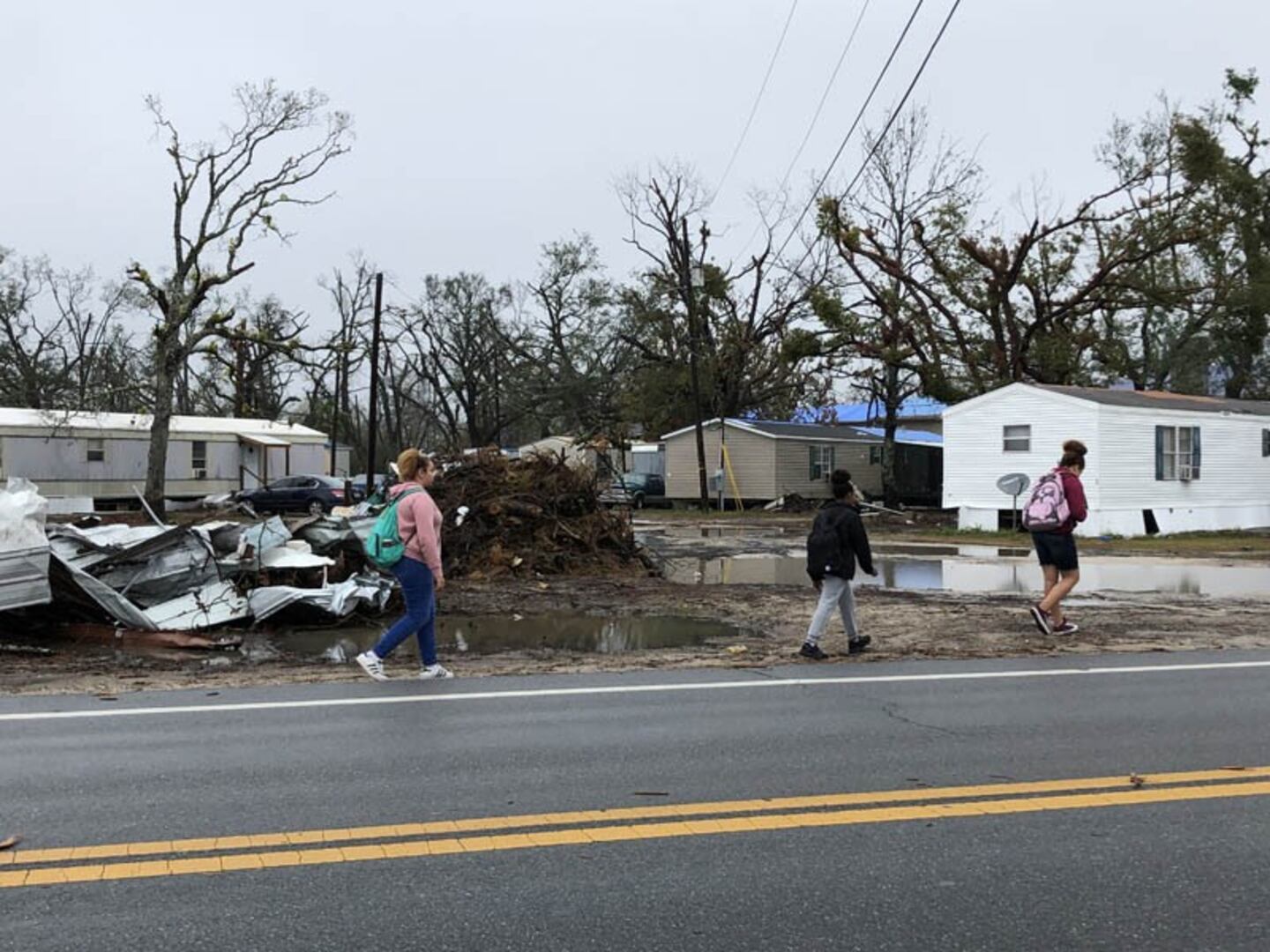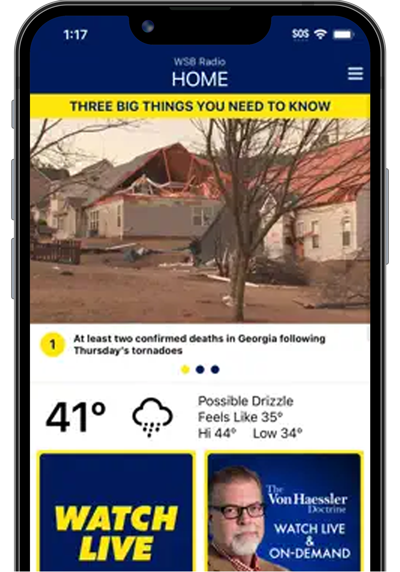In the midst of a bountiful holiday season, the people of southwest Georgia and the Florida panhandle are struggling. Two months after Hurricane Michael roared ashore near Panama City, they’re still disoriented by the breathtaking extent of the storm’s destruction. While we celebrate the holidays with friends and family, hurricane survivors like Yalonda Crews, who are living under blue tarps, in hotels and shelters say, “We’ve been forgotten.”
Afraid of the Rain
Belinda Martin, whose home was severely damaged as Hurricane Michael came ashore just three miles away, can no longer enjoy the sound of rainfall. It reminds her of being inside the three-bedroom house as the winds picked up and began to pummel her neighborhood.
Her husband, Ben and son Jackson stayed with her in defiance of the mandatory evacuation order that send hundreds of thousands of people inland, scrambling for safety. On October 10, as Michael steamrolled into the Florida panhandle with winds that topped 155 miles an hour, the Martins watched in horrified fascination as their neighborhood in the town of Callaway began to shred. As the worst of the storm, the hurricane eye wall, approached, Ben and Jackson ventured out into the yard.
“Above the roar of the 170-plus mile an hour winds came a train,” Ben said. “We both looked at each other and said, ‘Time to get in.’”
Ben and his son scrambled back inside the house and, together with Belinda, ran into the garage they had converted into a safe room.
“Jackson, get your helmet on!” Belinda shouted above the roar of the approaching tornado. They all donned motorcycle helmets and leather jackets—their personal armor against the tremendous force of the storm. The tornado passed within 50-yards of the Martin home, Ben said, destroying other houses in the neighborhood and killing at least one person. The roof of the carport nearby partially detached from its anchors and began flapping in the hurricane-force wind.
Belinda’s anxiety attacks began a week later, as she emptied her refrigerator and cooked on her gas grill for other survivors in the neighborhood. She had chest pains. She suffered fainting spells.
“I finally had to take her away,” Ben said. They were gone for a month.
Back home for six weeks now, Belinda no longer suffers the symptoms of her post-traumatic anxiety. But the slightest weather disturbance brings them back, she said.
“I can’t stand to listen to the rain. It just reminds me of being in that room and the sound of the carport roof flapping in the wind,” she said, her eyes growing dark and troubled at the mere thought of being back in the garage during the worst of the storm.
“You won’t think anything’s been done.”
The devastation is by no means confined to the Florida Panhandle. Georgia State Sen. Dean Burke (R-11), who is also the administrator of Memorial Hospital, drives slowly through his hometown of Bainbridge. More than two months after Hurricane Michael rolled across his district, still a Category 4 storm, he still marvels at the destruction left in its wake.
“It’s the worst thing I’ve ever been through, personally,” said Burke. “This was like a tornado, but it was eight counties wide and lasted for two hours rather than five minutes, like a tornado would.”
Bainbridge Memorial Hospital and Manor survived the storm with relatively little structural damage—unlike the buildings that surround it. But its generators weren’t up to the task when Michael knocked out power to the city and surrounding area.
“From a patient-care standpoint, we did well. The staff are heroes,” he said with only the slightest hint of pride in his voice. “We had extra staffing on hand and more ready if needed. Physicians spent the night at the hospital in case their drive into work was blocked.
“The number one problem we had was feeding our staff and our patients,” he continued. “Our generators are focused on patient care activities and patient care areas. We’ve never had a power outage as long as this was, so that it began to affect our ability to feed people.”
The hospital was out of power for a day—deemed a priority by emergency crews who flooded the storm-ravaged areas of Georgia and Florida with hundreds of thousands of workers. Electricity was restored at Memorial Hospital and Manor within a single day. But the lights remained off for just about everyone else for more than a week after that.
Burke stops for a red light at the intersection of Shotwell St. and South Lamar.
“You see that sign there where there is no sign?” he asks, pointing through the windshield to a gravity-defying jumble of twisted metal and torn fabric. “There used to be a billboard there. The KFC sign is gone. The Hardee’s sign is gone.”
He turns onto South Lamar, shaking his head. “It’s kind of interesting. The places you’ve been your whole life—a lot of landmarks are just gone. It’s just… just… surreal. It’s amazing how emotional you feel. I’ve been out of town four or five times since the storm,” he said, referring to his frequent trips to the state capitol in Atlanta. “And when I get back to the district that’s been so hard-hit, your stomach does flips.”
In Callaway, the damage is even much worse.
“You’re going to get here and think that nothing’s been done,” warned one FEMA worker. “It still looks that bad.”
It does.
Mile after mile, street after street, the damage is simply breathtaking. Most of the trees that lined those streets have been knocked down by the storm and chopped up by clean-up crews, sitting now in tremendous heaps of roadside rubble. Those left upright stand at crazy, unnatural angles against the sky, stripped of their leaves and branches like ghostly sentinels overwhelmed by the raw power of Hurricane Michael.
Most storm survivors are overwhelmed by a strong sense of disorientation.
“Now, without the trees, you can see places you didn’t even know were there,” said Yalonda Crews, another Callaway resident. “I used to know the backroads and how to get around town. But I don’t know how to get around anymore because the landmarks are gone.”
“It’s unrecognizable,” Belinda Martin said, nodding in agreement. “Thank God for Google Maps. That’s the only way I know to get around anymore.”
“Where did everybody go?”
The streets of Callaway, Mexico Beach and Panama City are remarkably quiet. The few people who venture out walk with their heads down, not looking at the tremendous destruction around them, pausing only to step around the rubble of destroyed buildings and trees. So far, authorities have said more than 16-million cubic yards of debris has been removed from Florida alone. There’s still about 9-million cubic yards to be collected and hauled to landfills. How much is that? If you stacked it up, it would be almost the size of the Empire State Building. In Georgia, FEMA reported 3.4 million cubic yards of debris has so far been removed in 13 counties. And the cleanup effort continues there as well.
But the mountains of debris, the shattered buildings and the still-sagging powerlines aren’t the only signs of damage caused by Hurricane Michael.
Consider the jobs lost to the hurricane.
“We lost more than 10,000 jobs when that storm hit,” said survivor Ben Martin. Without jobs, many people simply left. Heavily damaged by the 155 mile an hour winds, Bay Medical Sacred Heart Hospital in Panama City laid off 800 workers, approximately half the staff. The hospital has now been sold by Ardent Health Services to Ascension Sacred Heart, a chain of hospitals with facilities in Destin, Jacksonville, Miramar Beach, Port St. Joe and Pensacola.
Before the hurricane, Bay Medical employed 300 doctors and 1700 other workers and had 323 patient beds. Now, the hospital, except for the Emergency Room, is closed and won’t reopen until sometime next year. When it does, it will have just 75 beds.
Bay District Schools lost approximately 2620 students in the wake of Hurricane Michael.
“Before the storm, the average class size was 22,” said Belinda Martin. “Now the average class size is about 10.”
Many businesses are simply gone. Most malls and shopping centers remain shuttered because of the damage and won’t be open for the crucial Christmas shopping season. As businesses remain closed, more and more people leave, seeking work elsewhere. The Martins said many of their neighbors have left town. Many, they said, won’t be coming back.
“I have to stay strong for my children.”
Yalonda Crews, her husband and their five children heeded the mandatory evacuation order that went into effect two days before Hurricane Michael slammed into the Florida coast on October 10. They stayed in Mobile as the storm chewed up homes and businesses, destroyed infrastructure and left dozens of people dead.
The latest toll is 43, a number released November 28th by the Florida Division of Emergency Management. That includes an 11-year old girl who died when winds destroyed part of her home in Seminole County.
One woman died from an infection she apparently developed after spending weeks in the polluted floodwaters inside her home in Florida’s Gulf County. Another was killed after she fell during the evacuation. Others were killed by falling trees and in collapsed buildings. Some were simply swept away by the storm surge. Many died during the cleanup. And the number of those whose lives were claimed by Hurricane Michael is expected to increase over time as the recovery effort continues.
But the death toll only tells part of the story. Hurricane Michael took a toll among the living as well.
Take Yalonda, for instance.
“I feel guilty because I left,” she said. “Because some of my friends stayed and now they have PTSD (post-traumatic stress disorder).”
Tears welled up in her eyes. “I can’t believe I’m doing this,” she sniffled. “Usually I don’t do this. I guess I have suppressed it.”
“Sometimes I sit here during the day and just cry,” said Belinda Martin, tears filling her eyes as well.
It happens. Strangers in line at the grocery store start talking about the damage they’ve suffered, the trauma of the storm and its aftermath. Soon, they’re hugging and crying as if they were family instead of strangers. Both Crews and Martin said they cry almost daily, often joined by tenants and owners in the offices of the property management company where they work. The stress of facing a monumental cleanup, the disorientation, the financial worries, the displacement… it adds up. And they cry.
“I just don’t think about it,” Yalonda said through her tears. “This is the first time I’ve thought about it. I have to be strong for my children and my coworkers. I’m not going to break down. I’m not.”
What happens if she does?
“It would make them want to take care of me,” she added. “My kids aren’t supposed to take care of me, I’m supposed to take care of them. And I can’t let them down.”
“Glad to meet you guys! Y’all got the checks!”
“Good morning, sir!”
North of Callaway, in Albany, Georgia, Jose Vidal is a bright face among the rubble. He and his partner are going door-to-door in a rural neighborhood near Southwest Georgia Regional Airport. Vidal is one of hundreds of volunteers with the Federal Emergency Management Administration who have flooded the neighborhoods blasted by Hurricane Michael, trying to spread the word about the help FEMA can deliver in the storm’s aftermath.
Walter Goodman, 84, is an Army veteran of the Vietnam conflict. He’s a widower and has been living alone in his house on Goldenrod Road since his wife died nine years ago. His only companions—feral cats that crowd around his ankles as he puts out their food each morning. Two months after Hurricane Michael, he still can’t use the water in his house.
“(City inspectors) said I have a fungus in it,” Goodman says, standing on the back patio of his home. He can’t drink the water. He can’t even bathe in it without boiling it. The problem is, living on a small, fixed income, he doesn’t have the money to fix the water system.
Nor can he fix the damage to the roof on both his house and his detached garage. He had no idea what he would do—until Jose Vidal showed up on his doorstep.
“Glad to meet you guys!” Goodman cried out as Vidal and his small team approached his battered house. “Y’all got the checks!”
“Maybe you can get some help from FEMA,” Vidal told Goodman. “Did you file an insurance claim?”
“Yes, sir,” Goodman said. A veteran of more than two decades’ military service, Goodman knows how to talk to the government.
“Did they send you a check?”
“Yes, sir.”
“Did it cover everything?”
“No, sir,” Goodman replied. The check he received from his insurance company is hundreds of dollars short of what he needs to cover the cost of repairs to his roof and water line.
“If your insurance doesn’t cover some items,” Vidal said, his words colored by a thick Spanish accent. “Maybe FEMA can do that for you.”
Goodman liked that idea. Moments later, they were sitting at his kitchen table, as Vidal helped the elderly man apply for FEMA benefits.
Officials in Florida received 101,643 requests for information about FEMA assistance in the aftermath of Hurricane Michael. So far, fewer than 30,000 applications have been approved.
In Georgia, 35,902 people applied for FEMA assistance. So far, 4,598 have been approved. The process is not a fast one. Many grumble it’s not fast enough, but with more than 1,500 workers in the disaster zone, the agency is working at best possible speed to process applications and get money to those who need it.
By law, registration for FEMA help is limited to the first 60-days after an event like Hurricane Michael (excluding holidays). Sen. Burke said he was disappointed that more people didn’t know about the type of FEMA help for which they might qualify.
Those who didn’t apply by the deadline have 60 more days to put in their applications, but they must also file a letter stating
“I’ve been impressed by the aggressive way FEMA is trying to get the message out because media is fractured in Southwest Georgia,” said Burke. “But there is not one source of information anymore. We have radio, we have local newspaper and Facebook. But there is no one source that people go to” for information on what kind of government help might be available in Hurricane Michael’s aftermath.
Early estimates are that Michael caused more than $4.5 billion in damage to homes, businesses and infrastructure. Insurance companies will be tasked with paying out most of that money. FEMA, the Small Business Administration (SBA) and other government entities will pick up a fraction of the remaining costs.
The question is, when?
“Now the worry has set in.”
For Florida and Georgia farmers, Hurricane Michael is disaster upon tragedy. Last year, Hurricane Irma devastated the cotton crop. Michael did much the same—and worse.
“The shock of the storm is now gone,” said Tommy Dollar. One of Southwest Georgia’s agribusiness leaders, Dollar owns Dollar Farm Products, a family business founded during the Great Depression in 1938. He sits on the board of directors for a major local bank. He’s on the regional water board. If something involves farming in Southwest Georgia, chances are better than even Dollar knows all about it.
“Now the worry has set in,” he said. Every day, Dollar said, the requests are coming from farmers he’s known all his life:
“What about my loan at the bank? Can you work with us? Can you extend my payments for a month?”
“My cows need hay and all my hay got messed up in the barn.”
“I owe you money for defoliant I need to put on my cotton. Can you work with me on that?”
Early estimates of agricultural losses caused by Hurricane Michael, tallied separately from other losses, amount to $2.5 billion. That’s on top of the losses caused by Hurricane Irma in 2017.
In addition to all that, Dollar said farmers are worried about the possibility of a partial government shutdown over a disagreement between President Donald Trump and Democrats in Congress over the president’s demand for $5 billion to build a wall along the US-Mexico border. The shutdown wouldn’t affect FEMA—but it would affect many of the agencies to which FEMA refers disaster victims. They include the SBA and the US Department of Agriculture (USDA).
“If the government shuts down,” said Dollar, “it’s a multiplier effect.”
On top of disaster aid to farmers hit by Hurricane Michael, a new farm bill is pending in Congress. Disagreement over the president’s border wall could also stop that legislation cold in its tracks, Dollar said.
“The farm bill would give us some assurance that government is behind us. That would make the bankers feel better about loaning money with that new farm bill in effect. Without that insurance, it’ll be a multiplier, too. Instead of X happening, it’ll be two-times X,” he added. “That’s not a good thing.”
“We going to be okay, Mommy.”
The picture painted by Hurricane Michael and its Category 4 winds across the Florida panhandle and Southwest Georgia is a bleak one. But there is still hope. For instance, law enforcement officers throughout the region are going to extra lengths this holiday season to help children whose families have lost everything celebrate some semblance of a normal Christmas.
“Here at the Sheriff’s Office, we’re right in the middle right now of doing a toy drive,” said Sheriff Kevin Crews (no relation to Yalonda) in Washington County, Florida. “Our community has donated a lot of money to us.”
With that money, Crews and his 20 or so deputies will buy all the toys they can, then hand them out to the neediest children they can find, many of them still living in temporary apartments, motels, shelters or in homes with blue tarp on the roofs.
Back in Callaway, Belinda Martin unlocked her property management company’s key room to reveal mountains of toys—action figures, teddy bears and board games.
“There’s over 14,000 kids that are not going to have Christmas (because of Hurricane Michael),” she said. Is that a difficult task for the people of Bay County already dealing with problems that threaten to overwhelm them?
“No,” she answered simply. “You got to help the kids. Period.”
Similar toy drives are underway in Panama City, Bainbridge, Donalsonville and Albany.
In his mother’s arms shortly after Hurricane Michael sent eight trees crashing into the house he shares with his mother, Jennifer, three-year old Jeremiah Awls of Lynn Haven was anxious to talk to a reporter as they stood at a makeshift marketplace in a Sam’s parking lot. Looking for food, water and fuel, Jennifer Awls was worried—for herself and for her son.
But Jeremiah was serene about it all, even after surviving the harrowing storm.
“Don’t worry,” he said sweetly, cupping his mother’s cheek in his little hand. “We going to be okay, Mommy.”
To donate to the hurricane relief effort, contact the American Red Cross (www.redcross.org).
To help with the toy drives in Florida and Georgia, go to https://www.toysfortots.org/request_toys/Default.aspx.
Listen to audio from this story below:












